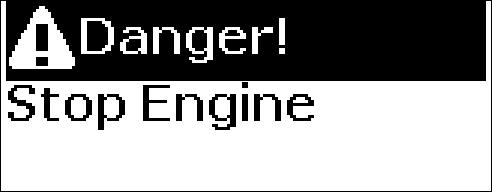
5 minute read
Fault Handling
Despite regular maintenance according to the maintenance schedule and perfect operation conditions faults may occur which must be attended to before the boat can travel further. This chapter describes alarms and fault handling.
P0006368
Alarm handling
Fault information from engine and EVC system
If a malfunction is discovered the driver is warned by a buzzer sounding and a pop-up showing in the display. The pop-ups will toggles between cause of fault and tasks to perform. Information regarding ”cause of fault” and ”measures to take” is found in chapter Fault Code Register page 44. The engine, transmission and EVC system is monitored by the diagnostic function. Should the diagnostic function discover a malfunction it protects the engine and ensures continued operation by affecting the engine. Depending on how serious the malfunction is the effect on the engine varies. • Minor malfunction which does not damage the engine or transmission.
Affect on engine: None. • Serious malfunction which will not immediately damage the engine or transmission e.g. high coolant temperature.
Affect on engine: Engine power is reduced until faulty value becomes normal. • Serious malfunction which will cause serious damage to engine or transmission.
Affect on engine: Engine power is reduced. • Serious malfunction which makes it impossible to control the engine or transmission.
Affect on engine: Transmission is disengaged and engine speed is reduced.
It is possible to perform emergency shifting, please refer to In Case of Emergency page 56. • Serious malfunction on transmission or in the engine fuel injection system.
Affect on engine: Engine is stopped.
It is possible to perform emergency shifting, please refer to In Case of Emergency page 56. In emergency situations it is also possible to start the engine with gear engaged after acknowledging the alarm.
P0004987
DANGER! Stop the engine immediately.
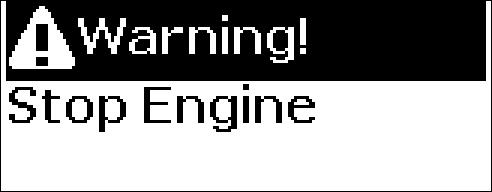
P0004986
WARNING! Stop the engine.
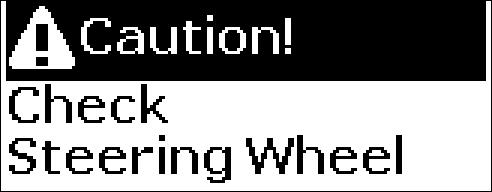
P0004985
CAUTION! See operator's manual. 1 Push the knob on the control panel to ackowledge the alarm. The buzzer becomes silent. 2 Read the alarm or message in the pop-up. 3 Push the knob on the control panel again and the pop-up disappears. NOTICE! The alarm has to be acknowledged before the engine can be started.
Popup windows
There are three levels of fault messages showing in the pop-up: danger, warnign and caution.
Danger
If the Danger pop-up is shown during operation, a serious fault has occured. Acknowledge the alarm and stop the engine immediately.
Warning
If the Waring pop-up is shown during operation, a fault has occured. Acknowledge the alarm and stop the engine at once.
Caution
If the Caution pop-up is shown during operation, a fault has occured. Acknowledge the alarm.

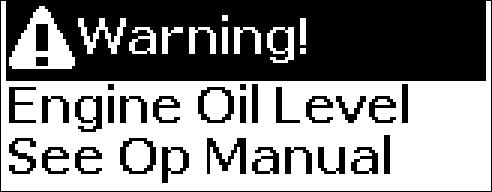
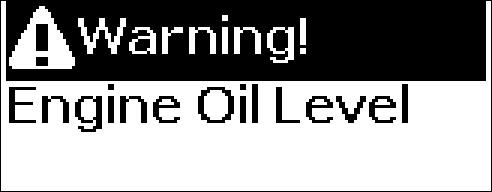
P0004375 Is a fault registered the display shows Faults in the EVC menu along with the number of faults. Push the knob on the control panel to open the menue. Turn the knob to see all faults registred. The popup toggles between cause of fault and tasks to perform.
Erasing faults in faults list
Acknowledged faults that has been stored automatically erased every time the starter key is turned to the stop position (S). Stop the engine and check that the ignition key(s) is (are) in position 0 in all control positions. When system voltage is switched on again, the diagnostic function checks whether there are faults in the EVC system. If this is the case, new fault pop-ups are shown. Faults which have been attended to or have disappeared are automatically erased. Faults which have not been attended to must be acknowledged every time the system voltage is switched on.
Fault Tracing
A number of symptoms and possible causes of engine malfunctions are described in the table below. Always contact your Volvo Penta dealer if problems occur which you can not solve by yourself. NOTICE! Read through the safety advice for care and maintenance work in the Safety Information page 6 chapter before starting work.
Symptoms and possible causes
Pop-ups are shown in the tachometer display Engine can not be stopped Starter motor does not rotate
See chapter Fault Code Register page 44 2, 4, 5, 7, 8 1, 2, 3, 4, 5, 6, 8, 9, 10, 36, 39 Starter motor rotates slowly 1, 2 Starter motor rotates normally but engine does not start 1, 11, 12, 13, 14, 38, 39 Engine starts but stops again 1, 11, 12, 13, 14, 19, 37, 39 Engine does not reach full operating speed at full throttle 12, 13, 14, 15, 16, 17, 18, 19, 20, 23, 34, 37, 39, 40 Engine runs unevenly 14, 15, 40 Engine vibrates 24 High fuel consumption 15, 16, 18, 21, 37 Black exhaust smoke 19 Blue or white exhaust smoke Lubrication oil pressure too low Coolant temperature too high Coolant temperature too low No charge or poor charge 21, 35 22 25, 26, 27, 28, 29, 30, 31, 32, 33 32 2, 27
1. Flat batteries 2. Poor contact/open circuit in cables 3. Main switch turned off 4. One of the circuit breakers in the distribution box has tripped 5. Faulty key switch 6. Control lever not in neutral/control position not activated 7. Faulty stop relay 8. Faulty main relay 9. Faulty starter relay 10. Faulty starter motor/solenoid 11. Lack of fuel: - fuel taps closed - fuel tank empty - wrong tank connected 12. Blocked fine fuel filter/pre-filter (caused by contamination or fuel stratification at low temperature) 13. Air in the fuel system 14. Water/contamination in fuel 15. Boat abnormally loaded 16. Fouling on hull/propeller 17. Cablage to unit injector damaged 18. Faulty unit injectors
19. Insufficient air supply to engine: - blocked air filter - air leakage between turbocharger and engine inlet manifold - fouled compressor section in turbocharger - faulty turbocharger - poor engine bay ventilation 20. Excessive coolant temperature 21. Too low coolant temperature 22. Too low oil level 23. Faulty / wrong propeller 24. Faulty engine mounting 25. Coolant level too low 26. Air in the freshwater system 27. Drive belt broken/slips 28. Faulty circulation pump 29. Closed seawater inlet 30. Blocked seawater inlet/pipe/filter 31. Defective impeller in seawater pump 32. Defective thermostat 33. Blocked heat exchanger insert 34. Blocked charge air cooler 35. Too high oil level 36. Water entry into engine 37. High back pressure in exhaust system 38. Faulty engine speed sensor 39. Stored fault codes 40. Non-return valve in feed pump leaks









